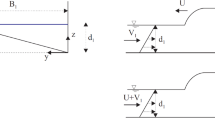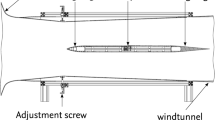Abstract
The paper presents experimental data on flow in the vicinity of a sudden elevation of channel bottom (step). The range of external flow parameters is considered for the case where the step generates waves. A distinguishing feature of these waves is that they are formed in transition from subcritical to supercritical flow. It is shown that there is a range of external parameters in which the depth at the channel exit, the depth above the step, and the distance from the step to the first wave trough depend exclusively on flow discharge.
Similar content being viewed by others
REFERENCES
R. E. Dreisler, “Comparison of theories and experiments for the hydraulic dam-break wave,” Int. Assoc. Sci. Hydrology, No. 38, 319-328 (1954).
J. J. Stoker, Water Waves. The Mathematical Theory with Applications, Intersciense Publishers, New York-London (1957).
H. Favre, Ondes de Translation dans les Canaux Decoverts, Dunod, Paris (1935).
V. I. Bukreev and A. V. Gusev, “Waves ahead of a vertical plate in a channel,”Izv. Ross. Akad. Nauk, Mekh. Zhidk. Gaza, No. 1, 82-90 (1999).
V. V. Smyslov, Theory of Spillway with a Wide Sill [in Russian], Izd. Akad. Nauk Ukr. SSR, Kiev (1956).
R. K.-C. Chan and R. L. Street, “A computer study ofinite amplitude water waves,” J. Comput. Phys., 6, 68-94 (1970).
V. Yu. Lyapidevskii and V. M. Teshukov, Mathematical Models for Propagation of Long Waves in Inhomogeneous Fluids [in Russian], Izd. Sib. Otd. Ross. Akad. Nauk, Novosibirsk (2000).
P. G. Baines, Topographic Effects in Stratifed Flow, Cambridge Univ. Press, Cambridge (1995).
V. I. Bukreev, “Undular jump in open-channel sill overow,” J. Appl. Mech. Tech. Phys., 42, No. 4, 596-602 (2001).
P. G. Kiselyev, Handbook on Hydraulic Calculations [in Russian], Gosénergoizdat, Moscow-Leningrad (1957).
Ven Te Chow, Open-Channel Hydraulics, McGraw Hill Book Co., New York (1959).
S. Wu and N. Rajaratnam, “Impinging jet and surface ow regimes at drop,” J. Hydraul. Res., 36, No. 1, 69-74 (1998).
L. V. Ovsyannikov, N. I. Makarenko, V. I. Nalimov, et al., Nonlinear Problems of the Theory of Surface and Internal Waves [in Russian], Nauka, Novosibirsk (1985).
V. I. Bukreev, E. M. Romanov, and N. P. Turanov, “Breaking of gravity waves in a neighborhood of their second critical propagation speed,” J. Appl. Mech. Tech. Phys., 39, No. 2, 205-210 (1998).
V. I. Bukreev and V. A. Kostomakha, Sudden blocking of a subcritical open-channel ow,” J. Appl. Mech. Tech. Phys., 42, No. 1, 35-41 (2001).
V. I. Bukreev, “Breaking of gravity waves in the motion of a vertical plate in a two-layer liquid,” J. Appl. Mech. Tech. Phys., 39, No. 5, 659-665 (2001).
Author information
Authors and Affiliations
Rights and permissions
About this article
Cite this article
Bukreev, V.I., Gusev, A.V. Waves behind a Step in an Open Channel. Journal of Applied Mechanics and Technical Physics 44, 52–58 (2003). https://doi.org/10.1023/A:1021725629052
Issue Date:
DOI: https://doi.org/10.1023/A:1021725629052




